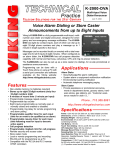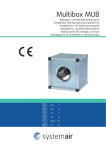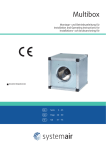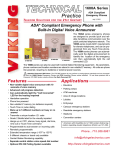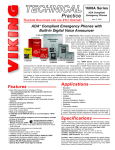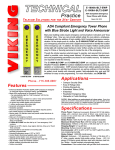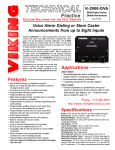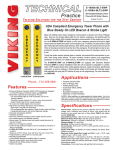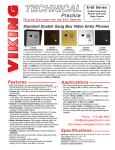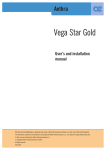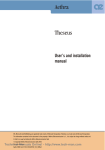Download Viking TBB-1 Specifications
Transcript
TECHNICAL
Practice
Practice
SECURITY
AND
E-1600A-TP-EWP
E-1600A-TP2-EWP
ADA Emergency Phones for
Talk-A-Phone Applications
C O M M U N I C AT I O N S O L U T I O N S
June 29, 2007
Direct Physical Replacement for Talk-A-Phone
Models ETP-400V and ETP-400DV Panel Phones
For use with Talk-A-Phone tower, pedestal, surface, wall
and flush mount enclosures. Code Blue towers require
redrilling and tapping.
E-1600A-TP-EWP
The E-1600A-TP-EWP or E-1600A-TP2-EWP will call up
to 5 programmable emergency numbers, as well as 2 central station numbers and send a digital announcement to
identify the location of the emergency call. The included
LDB-3 control module will supply a contact or switched
12V DC to activate a strobe light. In addition, the E-1600ATP2-EWP features a second “Info” button that will dial up
to 3 non-emergency numbers.
E-1600A-TP2-EWP
Though the strobe requires external power to operate,
voice communication is possible during power failures. All phone numbers, location numbers, voice announcement
and programming parameters are stored in non-volatile memory. No batteries are required.
The E-1600A-TP-EWP and E-1600A-TP2-EWP are equipped for outdoor or harsh environments with Enhanced
Weather Protection, which features: potted circuit boards, sealed trim pots and dip switches, rubber gaskets and
boots, gel-filled butt connectors, and extended operating temperature: -15°F to 130°F, tested to -35°F.
Phone...715.386.8861
Features
• Enhanced Weather Protection (EWP)
• Meets ADA requirements for Emergency Phones:
- Can automatically light the “Call Connected” LED for the
hearing impaired
- Transmits a unique location I.D. code or voice announcement
- Grade 2 Braille label for the visually impaired
• Non-volatile digital voice announcer with 16 seconds of
voice memory
• Provides contact or switched 12V DC for controlling a strobe light
• Advanced call progress detection
• Handsfree operation
• Phone line powered emergency phone (LDB-3 requires power)
• Non-volatile memory (no batteries required)
• Touch Tone or pulse dialing
• Dials up to 5 emergency numbers
• E-1600A-TP2-EWP can also dial up to 3 non-emergency
“Info” numbers
• Cycles through backup emergency and non-emergency
numbers on busy or no-answer
• Hangs up on CPC, silence, busy signal, dial tone, time-out or
Touch Tone command
• Programmable to auto-answer on incoming calls
• Remotely programmable
• Extended temperature range (-15°F to 130°F)
• Central Station Monitoring capability (dials 2 numbers)
• Separate central station voice speed dial number
• Optional PB-100 Polling System available (see page 10)
• High visibility, vandal and weather resistant
Applications
•
•
•
•
•
•
•
Campus Security Sites
Area of Refuge sites
Parking Ramps/Lots
Automated Tellers (ATM)
Entryways
Roadside Emergency Sites
Stairwells in Public Buildings
CAUTION - When installing on an analog extension of a phone system:
Some phone systems do not conform to analog telecom standards and might
not be compatible with the 1600A Series emergency phones. For a detailed
description of the telephone line specifications required for any of the 1600A
Series phones, retrieve Fax Back Document 869.
Specifications
Phone Power: Telephone line powered. Minimum 24V DC talk battery
voltage, with a minimum loop current of 20mA loop (room temp), or 25mA
(extended cold temp range). Loop current may be boosted on low current
lines with a Viking Model TBB-1 talk battery booster (Fax Back # 630).
LDB-3 Control Module: 120V AC/12V DC 500mA, UL listed
adapter provided
Dimensions: 241mm x 299mm x 51mm (9.5” x11.75” x2”)
Shipping Weight: kg ( lbs)
Mounting: Flush mount to Talk-A-Phone ETP towers, wall
mounts, boxes and pedestals
Environmental: -26°C to 54°C (-15°F to 130°F) with up to 100%
condensing humidity
Material: .125” (11 gauge) brushed stainless steel
Connections: Color-coded wires with gel-filled butt connectors
IF YOU HAVE A PROBLEM WITH A VIKING PRODUCT, PLEASE CONTACT: VIKING TECHNICAL SUPPORT AT (715) 386-8666
Our Technical Support Department is available for assistance weekdays between 8 a.m. and 5 p.m. central time. So that we can give you better service, before you call please:
1. Know the model number, the serial number and what software version you have (see serial label).
2. Have your Technical Practice in front of you.
3. It is best if you are on site.
RETURNING PRODUCT FOR REPAIR
RETURNING PRODUCT FOR EXCHANGE
The following procedure is for equipment that needs repair:
1. Customer must contact Viking's Technical Support Department at 715-386-8666 to obtain a Return Authorization (RA)
number. The customer MUST have a complete description of the problem, with all pertinent information regarding the
defect, such as options set, conditions, symptoms, methods to duplicate problem, frequency of failure, etc.
2. Packing: Return equipment in original box or in proper packing so that damage will not occur while in transit. Static
sensitive equipment such as a circuit board should be in an anti-static bag, sandwiched between foam and individually boxed. All equipment should be wrapped to avoid packing material lodging in or sticking to the equipment. Include
ALL parts of the equipment. C.O.D. or freight collect shipments cannot be accepted. Ship cartons prepaid to:
Viking Electronics, 1531 Industrial Street, Hudson, WI 54016
3. Return shipping address: Be sure to include your return shipping address inside the box. We cannot ship to a PO Box.
4. RA number on carton: In large printing, write the R.A. number on the outside of each carton being returned.
The following procedure is for equipment that has failed out-of-box (within 10 days of purchase):
1. Customer must contact Viking’s Technical Support at 715-386-8666 to determine possible causes for the problem. The
customer MUST be able to step through recommended tests for diagnosis.
2. If the Technical Support Product Specialist determines that the equipment is defective based on the customer's input
and troubleshooting, a Return Authorization (R.A.) number will be issued. This number is valid for fourteen (14)
calendar days from the date of issue.
3. After obtaining the R.A. number, return the approved equipment to your distributor, referencing the R.A. number. Your
distributor will then replace the product over the counter at no charge. The distributor will then return the product to
Viking using the same R.A. number.
4. The distributor will NOT exchange this product without first obtaining the R.A. number from you. If you haven't
followed the steps listed in 1, 2 and 3, be aware that you will have to pay a restocking charge.
LIMITED WARRANTY
Viking warrants its products to be free from defects in the workmanship or materials, under normal use and service, for a period of one year from the date of purchase from any authorized Viking distributor or 18 months from the date manufactured, which ever is greater. If at any time during the warranty period, the product is deemed defective or malfunctions, return the product to Viking Electronics, Inc., 1531 Industrial Street, Hudson, WI., 54016. Customer must contact Viking's
Technical Support Department at 715-386-8666 to obtain a Return Authorization (R.A.) number.
This warranty does not cover any damage to the product due to lightning, over voltage, under voltage, accident, misuse, abuse, negligence or any damage caused by use of the product by the purchaser or others.
NO OTHER WARRANTIES. VIKING MAKES NO WARRANTIES RELATING TO ITS PRODUCTS OTHER THAN AS DESCRIBED ABOVE AND DISCLAIMS ANY EXPRESS OR IMPLIED WARRANTIES OR MERCHANTABILITY OR FITNESS FOR ANY PARTICULAR PURPOSE.
EXCLUSION OF CONSEQUENTIAL DAMAGES. VIKING SHALL NOT, UNDER ANY CIRCUMSTANCES, BE LIABLE TO PURCHASER, OR ANY OTHER PARTY, FOR CONSEQUENTIAL, INCIDENTAL, SPECIAL OR EXEMPLARY DAMAGES ARISING OUT OF OR RELATED TO THE SALE OR USE OF THE PRODUCT SOLD HEREUNDER.
EXCLUSIVE REMEDY AND LIMITATION OF LIABILITY. WHETHER IN AN ACTION BASED ON CONTRACT, TORT (INCLUDING NEGLIGENCE OR STRICT LIABILITY) OR ANY OTHER LEGAL THEORY, ANY LIABILITY OF VIKING SHALL
BE LIMITED TO REPAIR OR REPLACEMENT OF THE PRODUCT, OR AT VIKING'S OPTION, REFUND OF THE PURCHASE PRICE AS THE EXCLUSIVE REMEDY AND ANY LIABILITY OF VIKING SHALL BE SO LIMITED.
IT IS EXPRESSLY UNDERSTOOD AND AGREED THAT EACH AND EVERY PROVISION OF THIS AGREEMENT WHICH PROVIDES FOR DISCLAIMER OF WARRANTIES, EXCLUSION OF CONSEQUENTIAL DAMAGES, AND EXCLUSIVE REMEDY AND LIMITATION OF LIABILITY, ARE SEVERABLE FROM ANY OTHER PROVISION AND EACH PROVISION IS A SEPARABLE AND INDEPENDENT ELEMENT OF RISK ALLOCATION AND IS INTENDED TO BE ENFORCED
AS SUCH.
FCC REQUIREMENTS
This equipment complies with Part 68 of the FCC rules and the requirements adopted by the ACTA. On the side of this
equipment is a label that contains, among other information, a product identifier in the format US:AAAEQ##TXXXX. If
requested, this number must be provided to the telephone company.
The REN is used to determine the number of devices that may be connected to a telephone line. Excessive REN's on a
telephone line may result in the devices not ringing in response to an incoming call. In most but not all areas, the sum of
the REN's should not exceed five (5.0) To be certain of the number of devices that may be connected to a line, as determined by the total REN's, contact the local telephone company. For products approved after July 23, 2001, the REN for
this product is part of the product identifier that has the format US:AAAEQ##TXXXX. The digits represented by ## are the
REN without a decimal point (e.g., 03 is a REN of 0.3). For earlier products, the REN is separately shown on the label.
The plug used to connect this equipment to the premises wiring and telephone network must comply with the applicable
FCC Part 68 rules and requirements adopted by the ACTA. If your home has specially wired alarm equipment connected
to the telephone line, ensure the installation of this E-1600A-TP-EWP does not disable your alarm equipment. If you have
questions about what will disable alarm equipment, consult your telephone company or a qualified installer.
If the E-1600A-TP-EWP causes harm to the telephone network, the telephone company will notify you in advance that
temporary discontinuance of service may be required. But if advance notice isn't practical, the telephone company will
notify the customer as soon as possible. Also, you will be advised of your right to file a complaint with the FCC if you
believe it is necessary.
The telephone company may make changes in its facilities, equipment, operations, or procedures that could affect the
operation of the equipment. If this happens, the telephone company will provide advance notice in order for you to make
the necessary modifications to maintain uninterrupted service.
If trouble is experienced with the E-1600A-TP-EWP, for repair or warranty information, please contact:
Viking Electronics, Inc., 1531 Industrial Street, Hudson, WI 54016 (715) 386-8666
If the equipment is causing harm to the telephone network, the telephone company may request that you disconnect the
equipment until the problem is resolved.
Connection to Party Line Service is subject to State Tariffs. Contact the state public utility commission, public service commission or corporation commission for information.
WHEN PROGRAMMING EMERGENCY NUMBERS AND (OR) MAKING TEST CALLS TO EMERGENCY NUMBERS:
Remain on the line and briefly explain to the dispatcher the reason for the call. Perform such activities in the off-peak
hours, such as early morning or late evenings.
It is recommended that the customer install an AC surge arrester in the AC outlet to which this device is connected. This
is to avoid damaging the equipment caused by local lightning strikes and other electrical surges.
PART 15 LIMITATIONS
This equipment has been tested and found to comply with the limits for a Class A digital device, pursuant to Part
15 of the FCC Rules. These limits are designed to provide reasonable protection against harmful interference
when the equipment is operated in a commercial environment. This equipment generates, uses, and can radiate radio frequency energy and, if not installed and used in accordance with the instruction manual, may cause
harmful interference to radio communications. Operation of this equipment in a residential area is likely to cause
harmful interference in which case the user will be required to correct the interference at his own expense.
Installation
A. Wiring
Rear View of the
E-1600A-TP-EWP Phone Panel
Preparing the Power Supply
Step 1. Cut off the barrel connector.
Step 2. Seperate the wires.
Step 3. Connect 12V adapter wires to power supply wires
on the LDB-3 Control Module using the supplied
butt connectors and then plug in power supply.
Step 2.
1600A Emergency
Phone Board
11 11
10 10
9 9
8 8
Step 1.
* Note: To increase surge protection, loosen the PCB mounting screw labeled
(as
shown) and fasten a wire with
ring connector (included) from
the mounting screw to Earth
Ground (grounding rod, water
pipe, etc.)
Step 3.
Ring Connector
(included)
7 7
Connect power supply
wires to LDB-3 module
power supply wires
6 6
S1
J1
ON
2
1
55
3
44
J2
J2
* Earth Ground
(optional)
33
2
(+) Black
(-) Black with
White Stripe
1
2
1
IMPORTANT: Do NOT plug in the
adapter until after Step 3 is completed.
Red (+)
Switched 12VDC (350mA
maximum) Output
11
Black (-)
10
Orange
LDB-3 Control
Module
9
Purple
8
Yellow
7
120V AC
** Gel-Filled Butt
Connectors (included)
Note: Polarity Sensitive!
*** Drip
Loop
12V DC
Adapter
Included
(+) Black
(-) Black with
White stripe
!
6
S1
ON
5
1
2
Blue
Blue
N.C.
COM.
N.O.
Auxiliary
Contact Output
3
2
Disable Feature
(see Programming section F)
Positions 3 and 4 come factory
wired directly to the 1600A
Emergency Phone Board
Red
1
(+) Red with
Black stripe
(-) Black with
White stripe
*** Note: When wires are routed from above, a “drip loop” is
recommended to keep water
away from the circuit board.
3
4
** Note: The gel-filled (watertight) butt connectors are
designed for insulation displacement on 19-26 guage
wire with a maximum insulation
of 0.082 inches. Do not strip
wires prior to terminating.
Green with Yellow stripe
Green
Red with Yellow stripe
*** Drip Loop
Incoming
Analog Phone
Line
IMPORTANT: Electronic devices are susceptible to lightning and power station electrical surges from both the AC outlet and the telephone line. It is recommended that
a surge protector be installed to protect against such surges. Contact Panamax at (800) 472-5555 or Electronic Specialists Inc. at (800) 225-4876.
B. Mounting
9.50
0.875
7.750
0.75
4.50
EMERGENCY
PHONE
5.125
Typ
11.75
10.250
Minimum Cutout
MODEL E-1600A-TP
CALL
CONNECTED
5.125
"Call Connected" LED
PUSH FOR
Push for "Help" Button ("Info" Button
available on model E-1600A-TP2-EWP)
HELP
VIKING©
Grade 2 Braille Label
2.125
0.75
2.75
4.00
2.75
(6) 0.250 diameter counter sunk 82° x 0.410
diameter holes for flathead #10 x 24
tamper-proof screws (not included)
LDB-3 Control Module Programming
A. DIP Switches
ON
OFF
Ring Indication Only.
OFF
ON
Off-Hook/Loop Current Detection Only.
ON
ON
Ring and Off-Hook/Loop Current Detection.
1
2
1
ON
Ring Cadence Mode ON - strobe remains activated in between rings.
OFF
Ring Cadence Mode OFF - strobe is activated only during ringing.
2
3
4
5
6
R
5
3
R
2
Ring Cadence Mode (see section B)
ON
CR
2
Sw 2
OFF
Z3
Description
Z2
Sw 3
R4
R7
R9
R8
Sw 1
7
8
9
10
11
1. Ring Indication Only
Place DIP switch 2 on the 1600A emergency phone board in the OFF position (not shown in the diagram - see
1600A Emergency Phone Board Programming section J). Note: With DIP switch 2 in the OFF position, the
1600A emergency phone board will not answer an incoming call. The LDB-3 control module can monitor for ringing any place along the ringing line. Place DIP switch 1 ON and DIP switch 3 OFF.
2. Loop/Off-hook Indication Only
Place DIP switch 1 OFF and DIP switch 3 ON. In this configuration, the E-1600-BLT will only flash the strobe light
while off-hook (while the emergency phone is in use).
3. Both Ring and Loop/Off-hook Indication
If the application requires ring and loop/off-hook indication, place DIP switch 1 and 3 in the ON position.
B. Ring Cadence Mode
DIP switch 2 is used for switching between different ring detection modes. In the OFF position, the strobe light and
relay will activate only while ring voltage is present and will turn off between rings. In the ON position, the strobe light
and relay will remain on for up to 5.75 seconds after the ringing has stopped. This allows the strobe light and relay to
remain on between rings of a standard ring cadence. Note: To use the Ring Cadence Mode, ring detection MUST be
enabled (DIP switch 1 - ON).
C. Relay Contacts
Normally open and normally closed relay contacts are available on the orange, purple and yellow wires. The contacts
are rated at .5A @ 125VAC/1A @ 30VDC. If contacts are driving an inductive load, place a suppression device at the
load to snub high voltage spikes.
D. Disable Feature
The “Disable” input can be connected to a switch for remotely disabling/turning off the strobe light and the device controlled by the auxiliary contacts (camera, etc.).
1600A Emergency Phone Board Programming
A. Accessing the Programming Mode
The 1600A emergency phone board can be programmed from any Touch Tone
phone using a C.O. line, analog PABX/KSU station, or a DLE-200B Line Simulator.
?
Need More Information on the DLE-200B?
Call (715) 386-4345 and select 605.
1. Using the Security Code
Step 1. Move DIP switch 2 to the ON position (sets unit to answer incoming calls, see section J).
Step 2. From a Touch Tone phone call the line attached to the 1600A emergency phone board.
Step 3. When the phone board answers, enter the 6-digit security code (factory set to 845464, see section C). A double
beep should then be heard indicating you have entered the programming mode.
2. Without the Security Code
Step 1. Move DIP switch 2 to the ON position (sets unit to answer incoming calls, see section J).
Step 2. Move DIP switch 3 to the OFF position (incoming calls enter Programming without security code, see section J).
Step 3. From a Touch Tone phone call the line attached to the 1600A emergency phone board.
Step 4. When the phone board answers, a double beep will be heard and will automatically enter the programming mode.
Step 5. When finished programming, move DIP switch 3 back to the ON position (see section J).
B. Quick Programming Features
Enter Digits - then - Enter Memory Location
First emergency speed dial number ......................................................................... 0-20 digits
Second emergency speed dial number ................................................................... 0-20 digits
Third emergency speed dial number ....................................................................... 0-20 digits
Fourth emergency speed dial number ..................................................................... 0-20 digits
Fifth emergency speed dial number ......................................................................... 0-20 digits
Central station receiver number ............................................................................... 0-20 digits
Central station voice number ................................................................................... 0-20 digits
First “Info” speed dial number (model E-1600A-TP2-EWP only) ............................. 0-20 digits
Second “Info” speed dial number (model E-1600A-TP2-EWP only) ........................ 0-20 digits
Third “Info” speed dial number (model E-1600A-TP2-EWP only) ............................ 0-20 digits
Voice announcer options (factory set to 000000) ..................................................... 6 digits
Timing/Dialing options (factory set to 234111) ......................................................... 6 digits
Security code (factory set to 845464) ...................................................................... 6 digits
Identification number (factory cleared) .................................................................... 0-20 digits
To add a , at any point in the dialing string .............................................................. ,,
To add a # at any point in the dialing string .............................................................. ,#
To add a four second pause at any point in the dialing string ................................... ,7
To switch to pulse dialing at any point in the dialing string ........................................ ,6
To clear any speed dial number ............................................................................... (no digits)
then
then
then
then
then
then
then
then
then
then
then
then
then
then
then
#00
#01
#02
#03
#04
#05
#06
#07
#08
#09
#17
#18
#19
#20
#00 - #09
Note: A double beep indicates a valid memory position, four beeps indicate an error.
C. Security Code (memory location #19)
The security code allows the user/installer to program the 1600A emergency phone board while DIP switch 3 is in the
ON (normal) position. The factory set security code is 845464 (V-I-K-I-N-G). It is recommended that the factory set
security code be changed. Example: To store 123456 as the security code:
Step 1. Access programming as shown is Programming section A.
Step 2. Enter 123456 #19..
Step 3. Hang-up.
Note: The security code must be 6 digits and cannot include a , or a #.
Enter Your Security Code Here:
#19
D. Speed Dial Numbers
Note: Up to 20 digits can be stored in each dial position. Special features such as pause, mode change, Touch Tone
, and # count as single digits.
1. Emergency Speed Dial Numbers (memory locations #00 - #04)
The emergency speed dial number programmed in location #00 is the number that
is dialed when the “Help” button is first pressed. Additional speed dial numbers will
be dialed when there is no answer or a busy signal is detected and the next number redial features are activated. To program, enter the desired speed dial number
followed by the location number (#00 - #04). To clear a speed dial location, simply
enter the memory location (#00 - #04) alone. The 1600A emergency phone board
is factory set with no speed dial number programmed.
To Program:
Enter:
,
,,
#
,#
4 second pause
,7
switch to pulse mode
,6
0, 1, 2...9
0, 1, 2...9
2. “Info” Speed Dial Numbers - model E-1600A-TP2-EWP only (memory locations #07 - #09)
The information speed dial number programmed in location #07 is the telephone or extension number that is dialed
when the “INFO” button is first pressed. Additional information speed dial numbers will be dialed when there is no
answer or a busy signal is detected and the next number redial features are activated. The 1600A emergency
phone board will cycle through the programmed speed dial numbers until answered. To program, enter the desired
speed dial number followed by the location number (#07 - #09). To clear a speed dial location, simply enter the
location (#07 - #09) alone.
3. Speed Dial Programming Examples
Step 1 See Section A
Step 2 - Enter Digits:
...to store 555-1234 as the first emergency speed dial number
Enter Programming
5551234#00
...to store a Touch Tone 9, a four second pause and then a pulse
dialed 333-4444 into the second speed dial memory position
Enter Programming
9 ,7 ,6 3 3 3 4 4 4 4 # 0 1
...to clear the first emergency speed dial number
Enter Programming
#00
To Program the 1600A Emergency Phone Board...
E. Identification Number (memory location #20)
The Touch Tone I.D. number (up to 20 digits) is used by emergency personnel to identify the location of the caller and
is given out when the receiving party presses a Touch Tone ,. The security office can display the number using a
Touch Tone decoder. To program the I.D. number, enter the desired number followed by #20. Example: To store 333
as the I.D. number, enter: 3 3 3 # 2 0
F. Timing/Dialing Options (memory location #18)
There are six positions in the timing/dialing options. To program these options, enter the six desired timing/dialing numbers followed by #18. The six available timing/dialing options are defined as follows:
Dial: A + B + C + D + E + F + # + 1 + 8
Factory Default Setting: 2 + 3 + 4 + 1 + 1 + 1
Enter Timing/Dialing Settings Here:
A
B
Talk/Listen Delay
Call Length
Silence Time Out
Dial Next Number on Ring No Answer
Dial Next Number on Busy
Pulse Dial Speed
Setting A - Talk/Listen Delay
This feature selects switching time between talk and listen modes (VOX switching time).
Use chart at the right. * Note: The factory default is .2 seconds.
C
D
E
F
#18
Touch
Tone
1
2
3
4
5
6
7
8
9
Talk/Listen
Delay
.1 sec
.2 sec *
.3 sec
.4 sec
.5 sec
.6 sec
.7 sec
.8 sec
.9 sec
Setting B - Call Length Time Out
This feature selects the maximum length of time that calls can be connected.
Programmable in increments of 1 minute up to a maximum of 9 minutes (Touch Tones 1 9). Program 0 in this location to disable the call length time out. With the call length disabled, the 1600A emergency phone board must rely on a CPC signal, busy signal, silence
or return to dial tone to hang-up. Use chart at the right. * Note: The factory default is 3
minutes.
Setting C - Silence Time Out
This feature selects the length of time that calls will remain connected without voice activity. Programmable in increments of 10 seconds up to a maximum of 90 seconds (Touch
Tones 1 - 9). To disable the silence time out, program 0 in this location. Use chart at the
far right. * Note: The factory default is 40 seconds.
Setting D - Dial Next Number on Ring No Answer
If enabled and a ring-no-answer is detected, the phone board will
dial the next programmed speed dial number, and continue to cycle
through the emergency numbers until a call is completed. * Note:
This feature is disabled in the factory default setting.
Touch
Tone
0
1
2
3
4
5
6
7
8
9
Call Length
Time Out
Disabled
1 min
2 min
3 min*
4 min
5 min
6 min
7 min
8 min
9 min
Touch
Tone
0
1
2
3
4
5
6
7
8
9
Silence
Time Out
Disabled
10 sec
20 sec
30 sec
40 sec*
50 sec
60 sec
70 sec
80 sec
90 sec
Setting D
Disabled*
Dials second number after
2, 3, 4...9 rings respectively
Touch Tone
1 or 0
2, 3, 4...9
Setting E - Dial Next Number on Busy
If enabled and a busy is detected, the 1600A emergency phone board will dial the
next programmed speed dial number, and continue to cycle through the emergency numbers until a call is completed. * Notes: This feature is disabled in the
factory default setting. If the busy signal is interrupted with a promotional message, contact your central office to have it removed.
Touch Tone
1
2
Setting E
Disabled*
Enabled
Touch Tone
1
2
Setting F
10 pps*
20 pps
Setting F - Pulse Dialing Rate (Pulses per second)
The 1600A emergency phone board is capable of different pulse dialing speeds.
* Note: The factory default setting is 10pps.
G. Voice Announcer Options (memory location #17)
The 1600A emergency phone board has a built-in non-volatile digital voice announcer that may be used to identify the
location of the emergency phone call. The 16 seconds of digital record time is recorded remotely from a Touch Tone
phone. Programming options are as follows:
Dial: A + B + C + D + E + F + # + 1 + 7
Factory Default Setting: 0 + 0 + 0 + 0 + 0 + 0
Two Digit Announcement Delay {
Enter Settings Here:
A
B
C
Repeat Announcement Setting
D
E
F
0
0
0 #17
Future Use (enter “0”)
Settings A and B - Announcement Delay
The 1600A emergency phone board is factory set to automatically start playing the voice announcement after it has determined the call has been
answered. Alternately, the announcement may be programmed to play after
a programmed amount of time, from 1 to 99 seconds after dialing.
Touch Tone
00
01-99
Setting A/B
Play automatically
1-99 seconds*
* Note: If the announcement delay time is used, you must allow enough time for the 1600A Phone Board to detect
ring-no-answer and busy signals when using the redial features. The factory default is set to play automatically.
Setting C - Repeat Announcement Option
The phone board can be programmed to play the announcement from 19 times, or to continuously repeat the announcement every 8 seconds
until a Touch Tone , is detected from the distant party. The I.D. number
(if programmed) will be sent and the call connected LED will turn on automatically after the announcement has stopped repeating.
Touch Tone
0
1-9
Setting C
Repeat every 8 secs*
Repeat 1-9 times
* Note: The factory default for the 1600A emergency phone board is to repeat until a , is detected (digit 0).
H. Recording the Announcement
Step 1. Call into the 1600A emergency phone board with a Touch Tone phone and access programming.
Step 2. Enter ,4, wait for the tone and then begin recording. Sixteen seconds of record time is available.
Step 3. Enter any Touch Tone to stop the recording. Playback is automatic.
Step 4. Enter ,5 to review the announcement again.
Step 5. If you choose to not use a voice announcement, enter ,3 to clear the recording.
Example: “Elevator number 1215, located in the Financial Building, needs assistance. Press the asterisk (,) key on
your telephone to start and stop this announcement...”
I. Automating the Call Connected LED
There are two methods of turning on the Call Connected LED. The LED will turn on after a Touch Tone , is detected
from the distant party or after the voice announcer is finished playing a programmed number of times. If you want the
Call Connected LED to light automatically when the call has been answered, but you don’t want a voice announcement
to be played, follow these programming steps:
Step 1:
Step 2:
Step 3:
Access Programming as shown in section A
Make a short (1 second) recording of silence
Enter digits: 001000#17
J. DIP Switch Programming/Speaker and Microphone Adjustments
Two POTs are provided to increase or decrease speaker volume and microphone sensitivity. In certain noisy locations
the microphone sensitivity may need to be decreased as shown below. Caution: Setting the microphone gain too high
may cause distorted audio, prevent the distant party from breaking over and inhibit second number redialing.
Rear View of the
1600A Emergency Phone Board
Speaker
Volume
DIP
Position
Switch
ON
1
Microphone
Sensitivity
DIP Switches
Off
1
2
3
On
(DIP Switches shown
in factory setting)
Description
”Help” button alternately connects and
disconnects calls (factory default)
OFF
”Help” button connects calls only
2
ON
Incoming calls answered (factory setting)
2
OFF
Incoming calls are not answered
3
ON
Normal operation mode (factory setting)
3
OFF
Learn mode - Any incoming calls are automatically entered into the programming
mode (no security code required). Use
this option if you have forgotten your security code.
1
K. Central Station Programming
The standard 1600A emergency phone board is capable of communicating using the “Ademco Contact I.D.”, “Ademco
High Speed”, “DTMF 4+1 Express”, or the “DTMF 4+2 Express” formats. All formats use the programming memory location #20 to store the account code and alarm details.
1. Central Station Programming Features
a. Accessing the Programming Mode
Before programming, you must access the programming mode (see Programming section A).
b. Enabling/Disabling Central Station Mode
The phone can be placed in the “Central Station Mode” by entering a central station phone number in position
#05 while programming. To cancel the “Central Station Mode,” clear position #05 by entering #05 only (see
Programming section D).
c. Ring Delay
When the phone is in the “Central Station Mode”, it is best to have the “Dial Next Number on Ring No Answer”
set to a minimum of three, because some receivers send a long tone after answering the line that sounds like
a ring back. If the phone is set to a ring delay of two, the phone will disconnect (see Programming section F).
To Program the 1600A Emergency Phone Board...
Step 1:
Step 2 - Enter Digits:
...to enable central station programming and dial 952-2567
Enter Programming
9522567#05
...to disable central station programming
Enter Programming
#05
d. Speed Dial Numbers
The 1600A emergency phone board can be programmed to dial a central station receiver only, or dial up to 5
voice numbers first, and if no answer, then dial the central station receiver. When calling the first numbers (memory positions #00-#04 (see Programming section D), the phone stays in “two-way talk mode” allowing two-way
conversation. When calling the Central Station number (memory position #05), the phone is in a “listen only
mode” in order to interpret the hand shake signals of the receiver.
A second central station number position has been provided in location #06 that is used when the central station receiver does not have a talk over mode. If a number is placed in position #05 and position #06 is cleared,
the phone will call the central station monitor receiver.
After the receiver sends a kiss-off, the phone lights the
Location Call Type
“Call Connected” LED and goes into two-way talk mode.
#00
Voice - Emergency
If numbers are in both positions #05 and #06, the phone
Voice - Emergency
#01
will call the receiver first, and after the kiss-off, will hangVoice - Emergency
#02
up and redial the number in position #06 for two-way
#03
Voice - Emergency
voice communication.
Notes: If only a central station is to be dialed, the central
station phone number must be preprogrammed in memory location #05 and memory locations #00-#04 must be
cleared. The “Call Connected” LED will light automatically if there is a voice recording programmed.
#04
#05
#06
#07
#08
#09
Voice - Emergency
Central Station Receiver
Central Station Voice Line
Voice - “Info” (E-1600A-TP2-EWP only)
Voice - “Info” (E-1600A-TP2-EWP only)
Voice - “Info” (E-1600A-TP2-EWP only)
2. Central Station Formats
The following examples explain the receiver formats and how to properly program memory location #20. Each format starts with a four digit account code. This is the code that is assigned by your central station for billing purposes. You must access the programming mode before programming these features (see Programming section A).
Important: If a number is shown, you must use that number. If an “X” is shown, use any appropriate number.
a. Ademco Contact ID Format
This DTMF format consists of a four digit account code, two digit message type, and a nine digit data field.
XXXX 18 1 14000 XXX #20
Account Code
Message Type
New Event
Enter Contact ID Settings Here:
Memory Location
Any number to identify phone
General Alarm
18 1 14000
#20
b. Ademco High Speed Format
This DTMF format consists of a four digit account code, eight zone codes and one alarm type digit. With this
format you can identify up to eight different phones by using a zone per phone. A “5” in a zone position means
no alarm. The following example shows an alarm from the third phone.
XXXX 55 1 55555 7 #20
Memory Location
Normal Alarm
New Event
Account Code
Idle Zone
Enter Ademco High Speed ID Settings Here:
55 1 55555 7 #20
c. 4+1 Express Format
This DTMF format consists of a four digit account code, two digit message type, and a single digit event code.
XXXX 17 X #20
Account Code
Message Type
Enter 4+1 Express ID Settings Here:
Memory Location
Event Code
17
#20
d. 4+2 Express Format
This DTMF format consists of a four digit account code, two digit message type, and a two digit event code.
XXXX 27 XX #20
Account Code
Message Type
Enter 4+2 Express ID Settings Here:
Memory Location
Event Code
27
#20
Operation
A. Standard Operation
1. “HELP” Button
When the “HELP” button is pressed, the E-1600A-TP-EWP phone goes off-hook and dials a pre-programmed telephone number. The Call Connected LED momentarily flashes during tone or pulse dialing. In the event that the
line is busy or there is a ring-no-answer, the unit can be programmed to call additional phone numbers. The phone
then cycles through up to 5 pre-programmed emergency numbers until the call is answered. When the call is
answered, handsfree communication to emergency personnel is established. The digital voice announcer will automatically play to identify the location of the emergency call. The , key will stop the announcement, send the I.D.
number (if programmed) and light the “Call Connected” LED. Alternatively, the phone can be programmed to automatically light the “Call Connected” LED after the announcement has played a programmed number of times. The
distant party will know the location of the emergency call by either the voice announcement or by decoding the
Touch Tone I.D. number. Pressing the , key again will send the I.D. number and play the message again. Once
the , key has been pressed, the # key can be used to force the phone to hang-up.
2. “INFO” Button (model E-1600A-TP2-EWP only)
When the “INFO” button is pressed, the phone goes off-hook and dials the first “INFO” phone number programmed.
If a busy signal is detected or the call goes unanswered, the phone will cycle through all three “INFO” phone numbers until the call is answered. When answered, handsfree communication is established. Note: The voice
announcement is for Emergency/Help calls only and will not play on a call initiated from the “INFO” button.
B. Central Station Operation
After the “HELP” button on the E-1600A-TP-EWP phone has been pressed, the E-1600A-TP-EWP phone will begin to
dial. If a voice number is programmed in memory locations #00-#04, these numbers will be dialed first. Upon detecting a busy signal or after a preprogrammed ring delay, the E-1600A-TP-EWP phone will hang-up and dial the central
station phone number stored in memory location #05. When the central station receiver answers, it will send a handshake tone to the E-1600A-TP-EWP. Upon detecting the handshake tone, the E-1600A-TP-EWP phone will begin
uploading the information stored in memory location #20.
Once the E-1600A-TP-EWP emergency phone has sent the information stored in memory location #20, it waits for a
“kiss-off” tone from the central station. When the “kiss-off” tone is received, the emergency phone turns on the call connected LED and goes into the “two-way talk mode” or hangs up and dials position #06 if programmed. Note: The central station should have a “talk-over” feature that will allow a two way conversation at this time. If your receiver does
not support “talk-over”, a voice phone number should be programmed into position #06. If the central station answers
the call and does not send a “kiss-off”, the next number will be dialed (if programmed). In either single number or multinumber programming, the phone will keep dialing until a call is completed.
Options
1600A Series ADA* Compliant Emergency Phones with Built-In Digital Voice Announcer
The 1600A Series ADA Compliant Emergency Phones are designed
to provide quick and reliable handsfree communication over the public switched telephone network. All 1600A Series phones meet ADA
requirements for elevator/emergency telephones, and can be programmed from any Touch Tone phone. The phones can dial up
to 5 programmable emergency numbers, as well as 2 central
station numbers. In addition, the E-1600-20A features an
"Info" button that will dial up to 3 non-emergency
numbers.
E-1600-02A
K-1600-EHFA
The 1600A Series phones can be programmed to
automatically deliver a digital announcement to identify the location of the emergency call and then initiE-1600-03A
E-1600A
E-1600-20A
E-1600-45A
ate the call connected LED light. Alternatively, a
E-1600-55A
DTMF Touch Tone code may also be delivered. All
programming parameters, including phone numbers and location numbers, are stored in non-volatile E2 memory. All units
are phone line powered, requiring no batteries or external power and are compatible with common Central Station
Monitoring equipment.
For outdoor or harsh environments, select 1600A Series phones are available with Enhanced Weather Protection (EWP).
EWP products feature rubber gaskets and boots, hand soldered silicon sealed connections, gel filled tip and ring connectors, as well as urethane potted circuit boards with weather sealed, field-adjustable trim pots and DIP switches for easy onsite programming.
Need More Information on the 1600A Series?
?
Call (715) 386-4345 and select 215.
PB-100 Polling and Diagnostics Kit
PB-100
System
The PB-100 system provides centralized polling and diagnostics of all Viking
1600 and 1600A series emergency phones through a standard Windows 9x/NT
P.C. In addition, any device or human capable of returning DTMF Touch Tones
can be automatically polled.
Up to 500 individual phones can be polled, at timed intervals, for the diagnosis
of proper programming and operation. The included software provides storage
of complete contact/location records associated with the phones ID. Devices
that are polled successfully are stored in a "success" log while devices that
returned any kind of error are stored in a "failure" log.
Product Support Line...715.386.8666
?
Need More Information on the PB-100?
Call (715) 386-4345 and select 860.
Fax Back Line...715.386.4345
Due to the dynamic nature of the product design, the information contained in this document is subject to change without notice. Viking Electronics, and its affiliates and/or
subsidiaries assume no responsibility for errors and omissions contained in this information. Revisions of this document or new editions of it may be issued to incorporate
such changes.
Fax Back Doc 218
Printed in the U.S.A.
ZF301960 Rev 2










